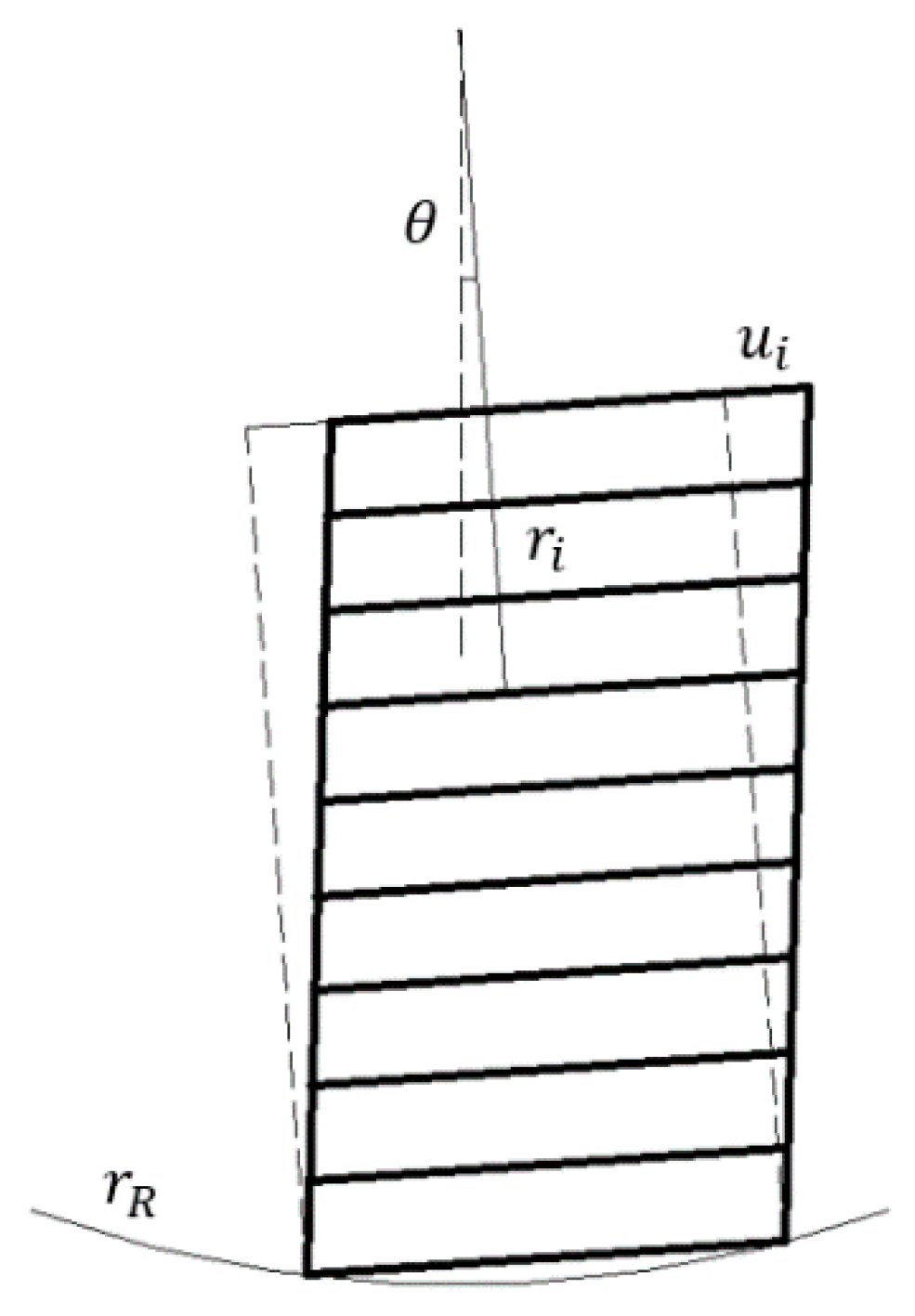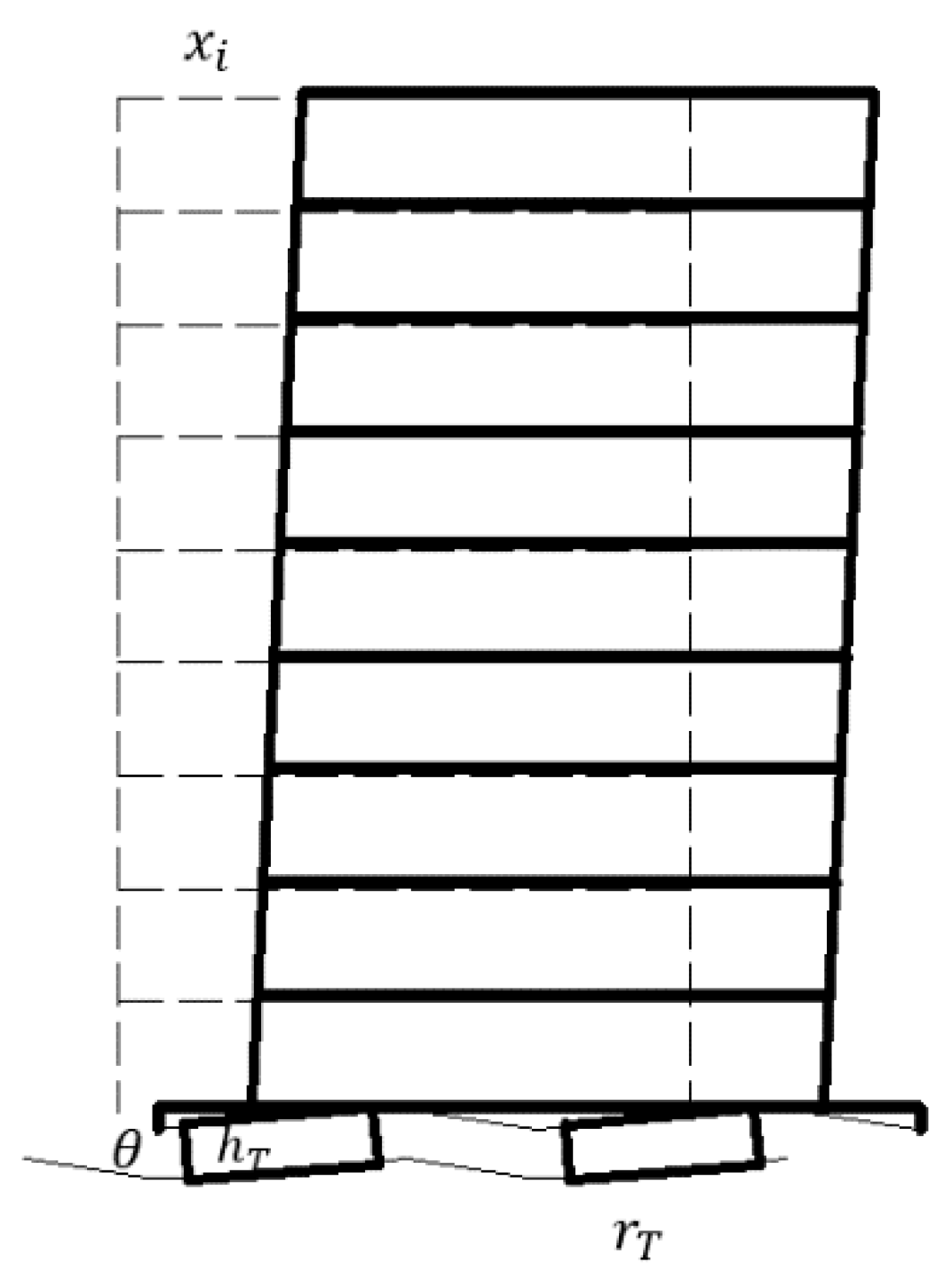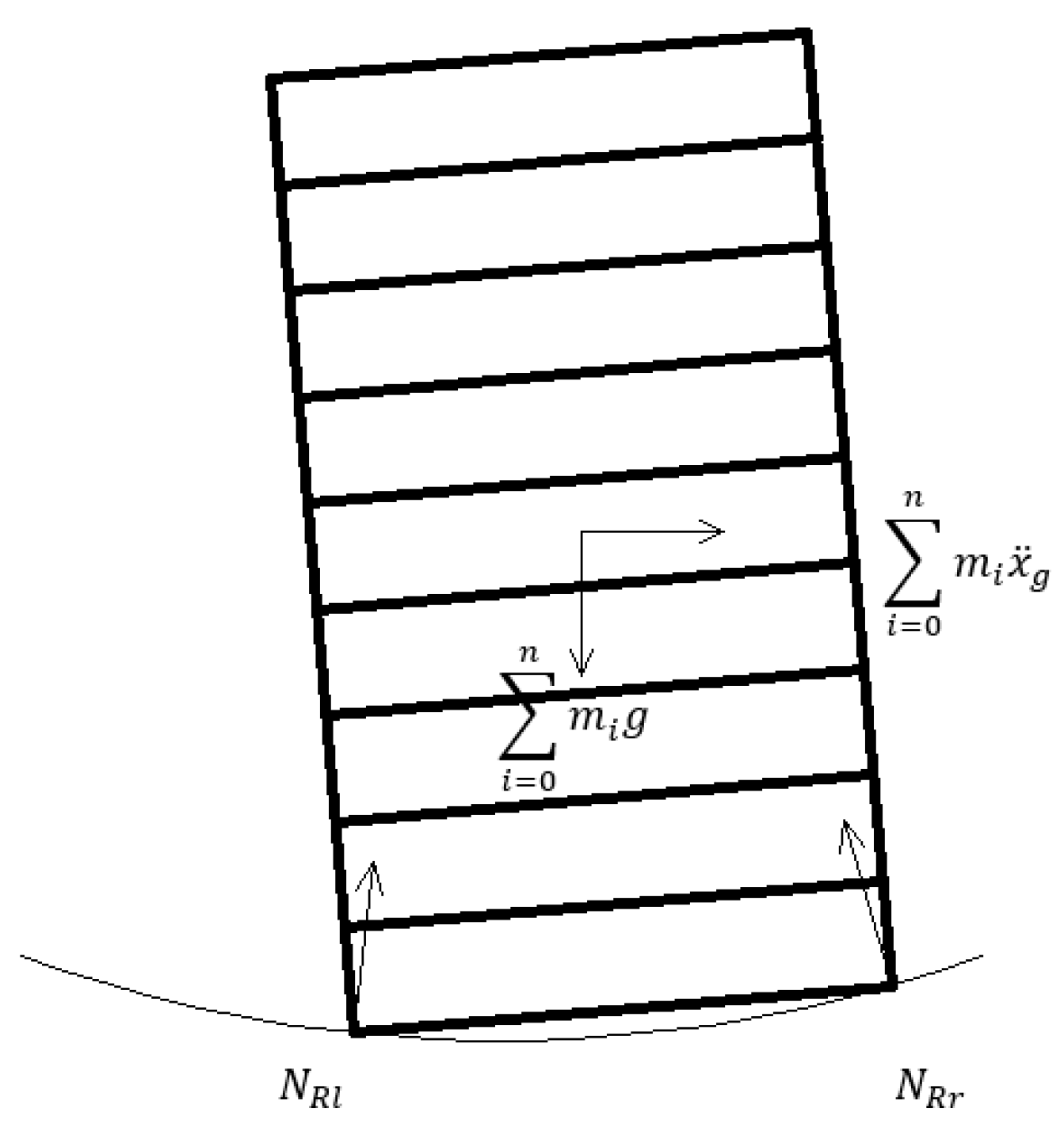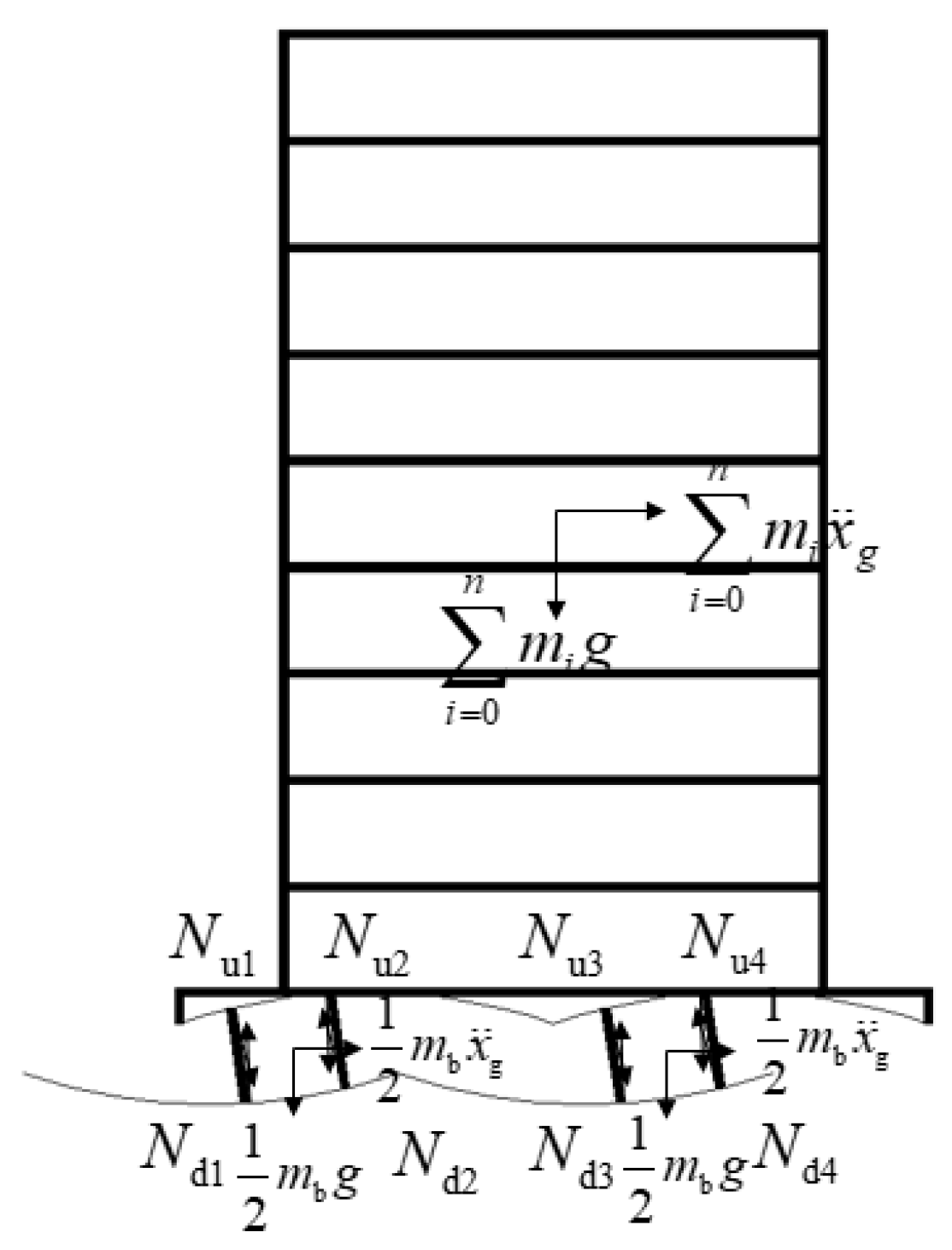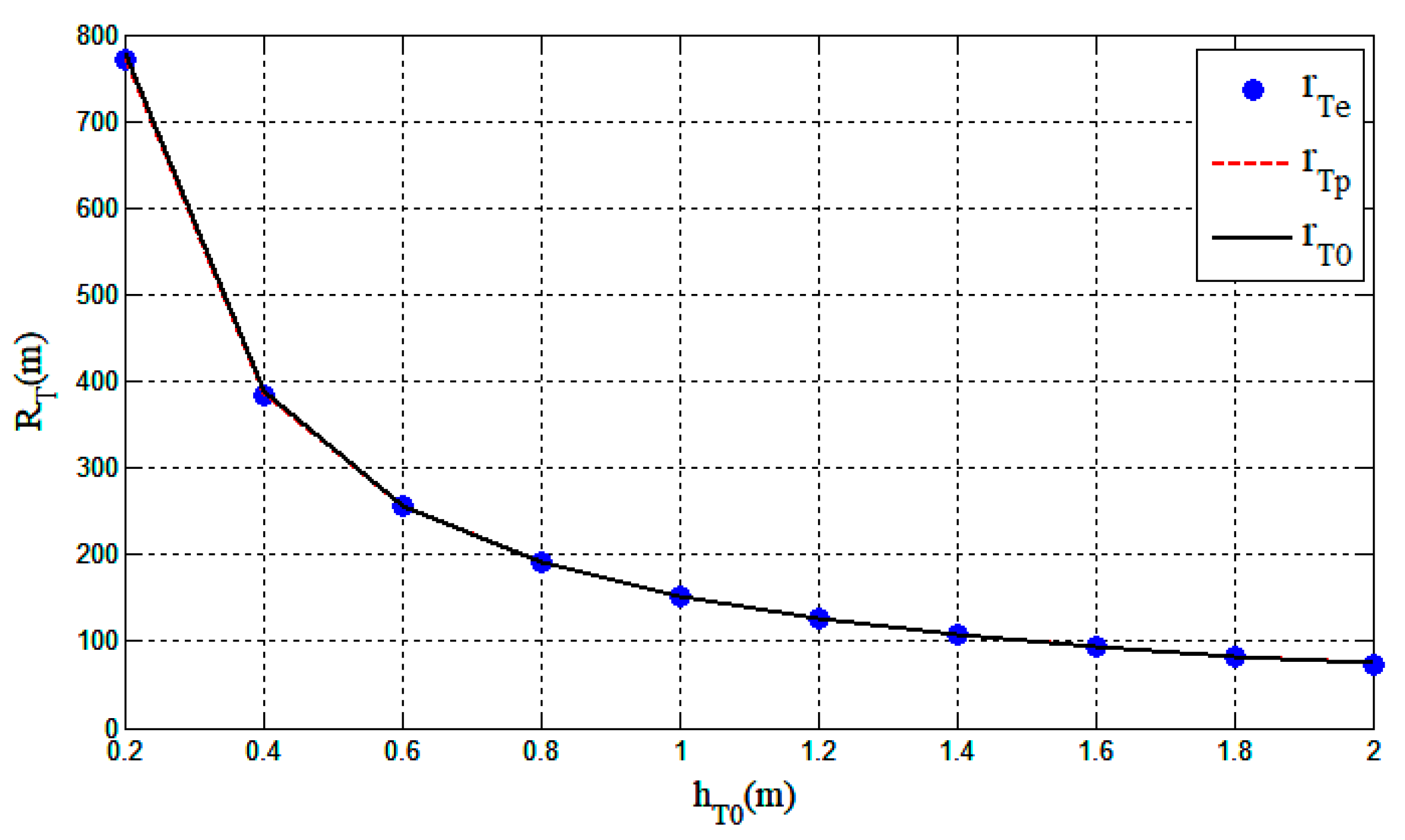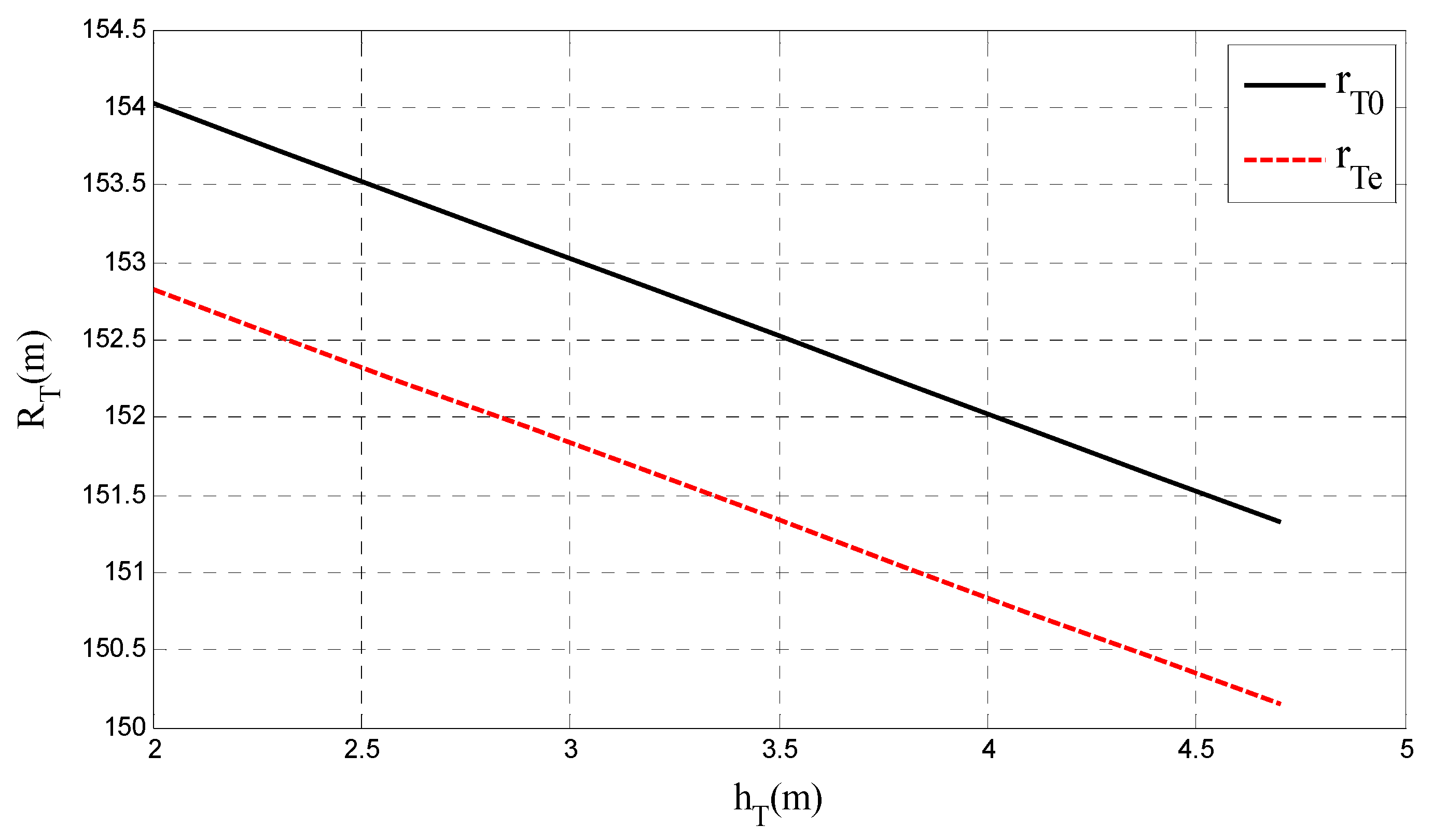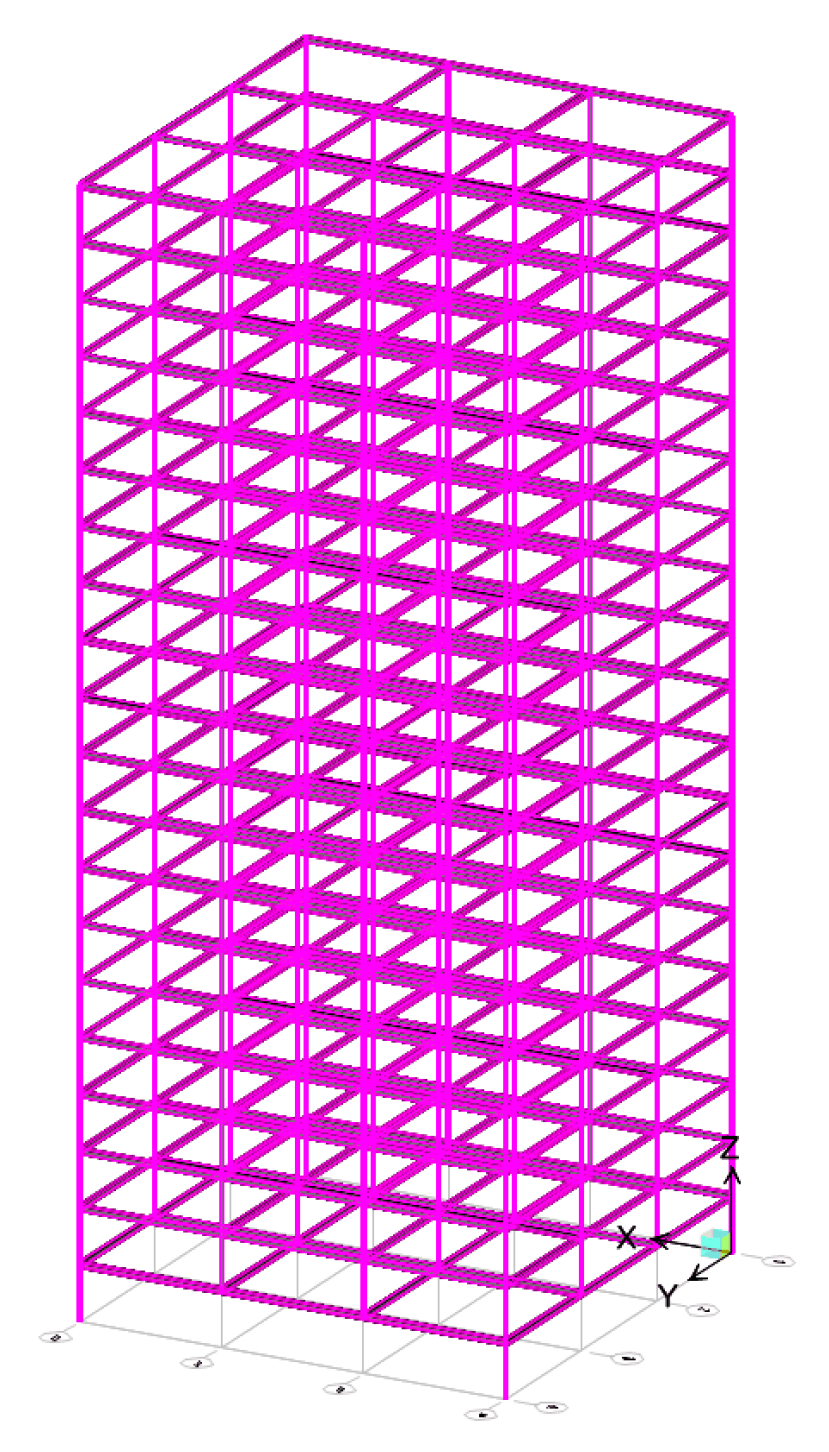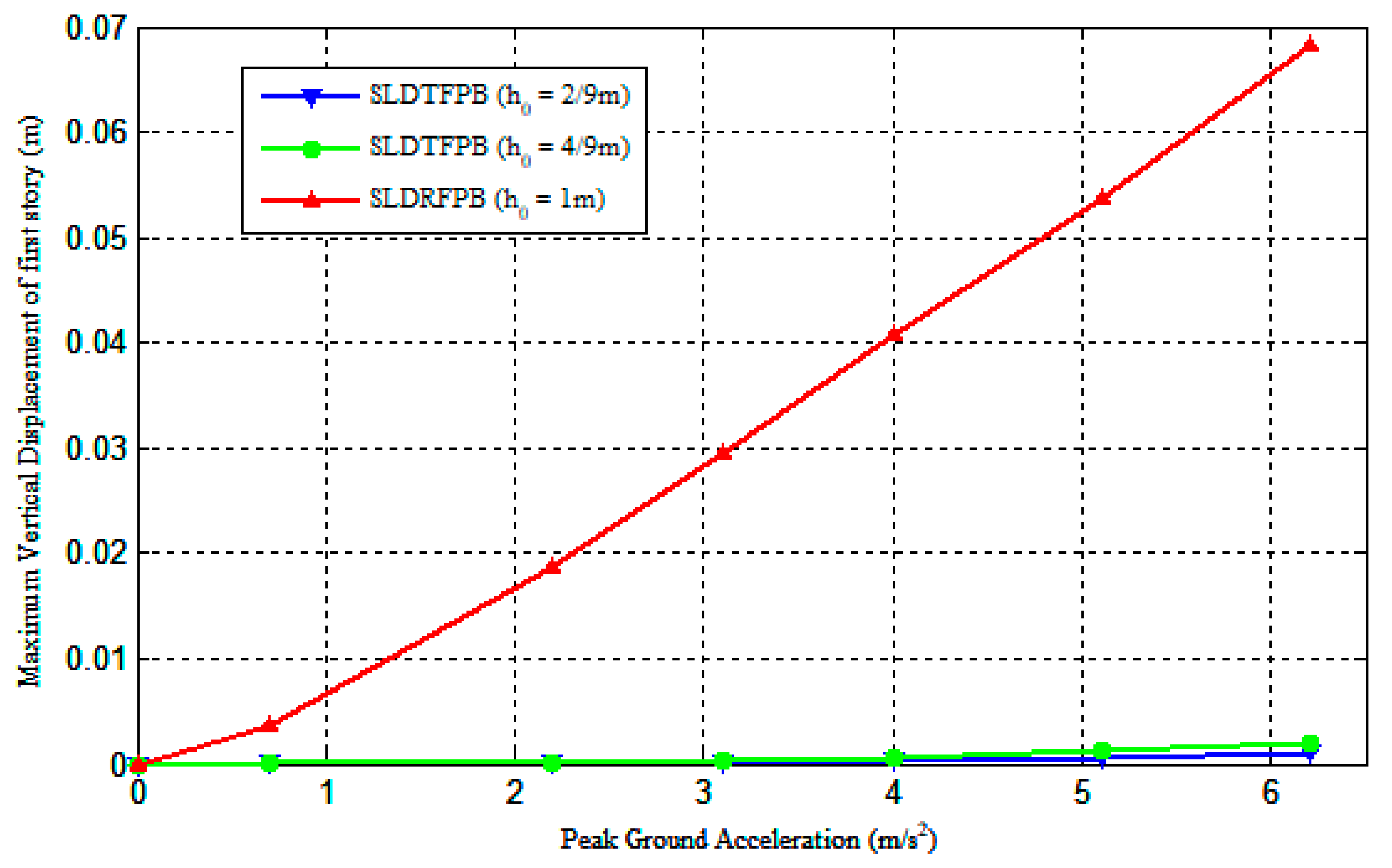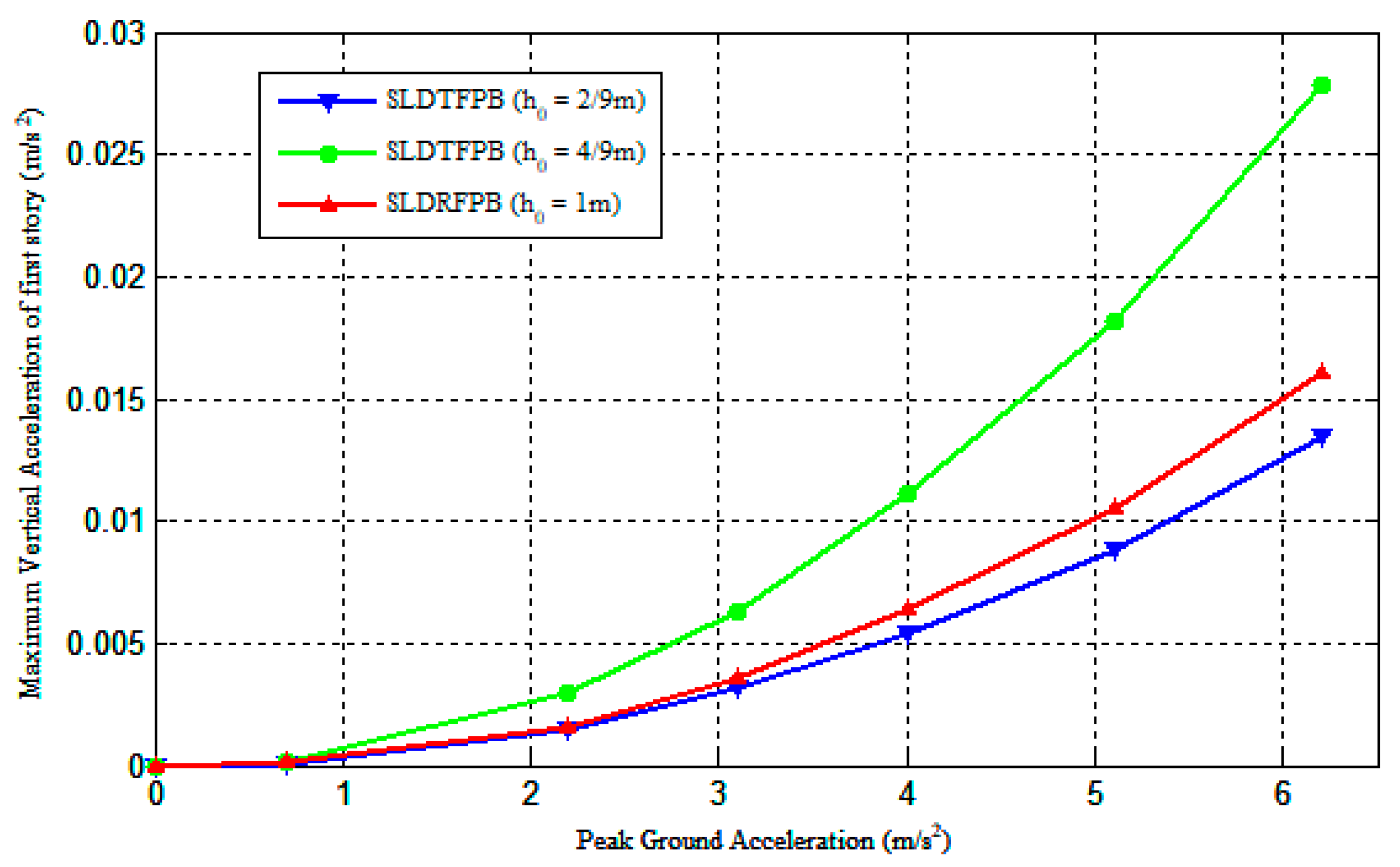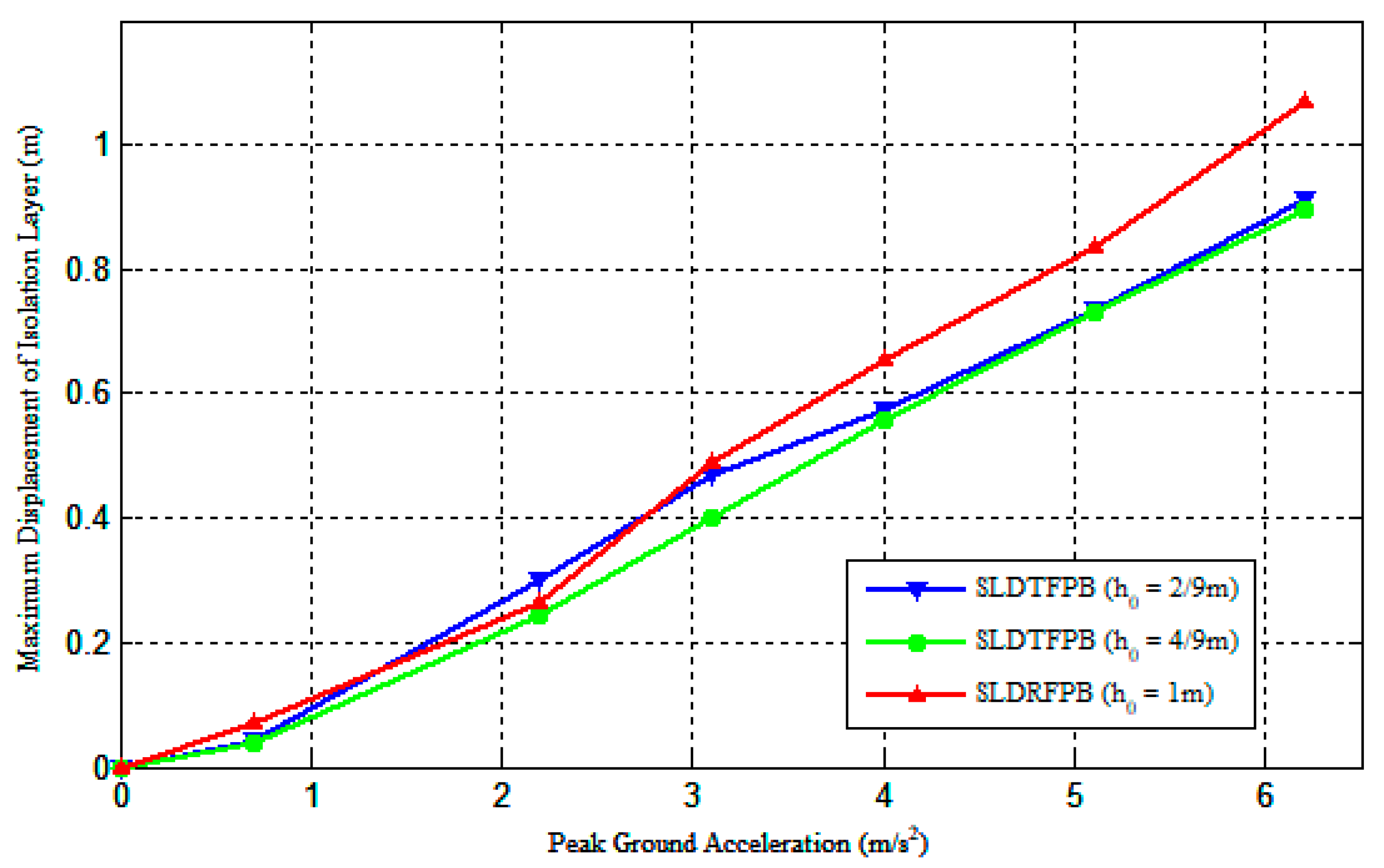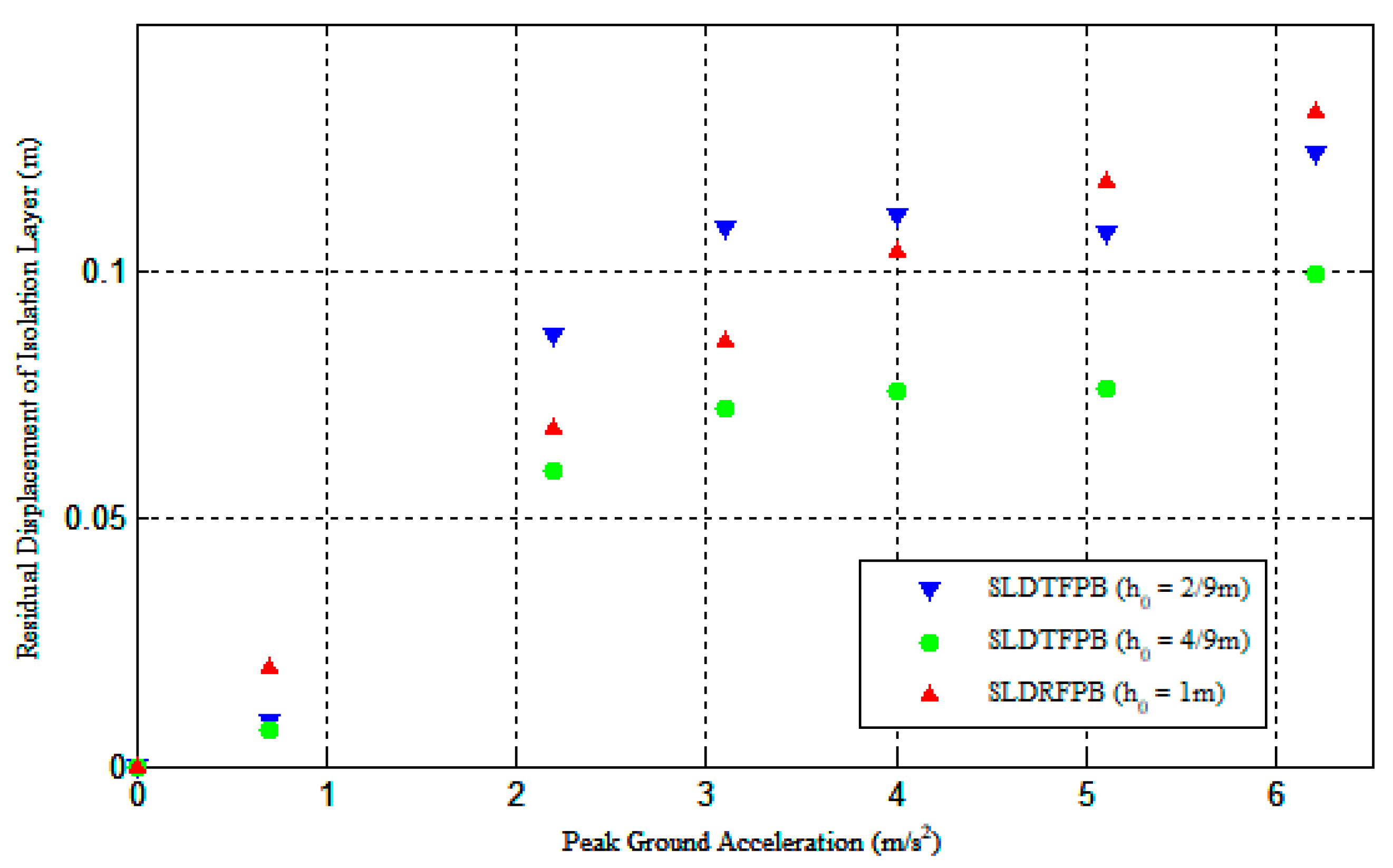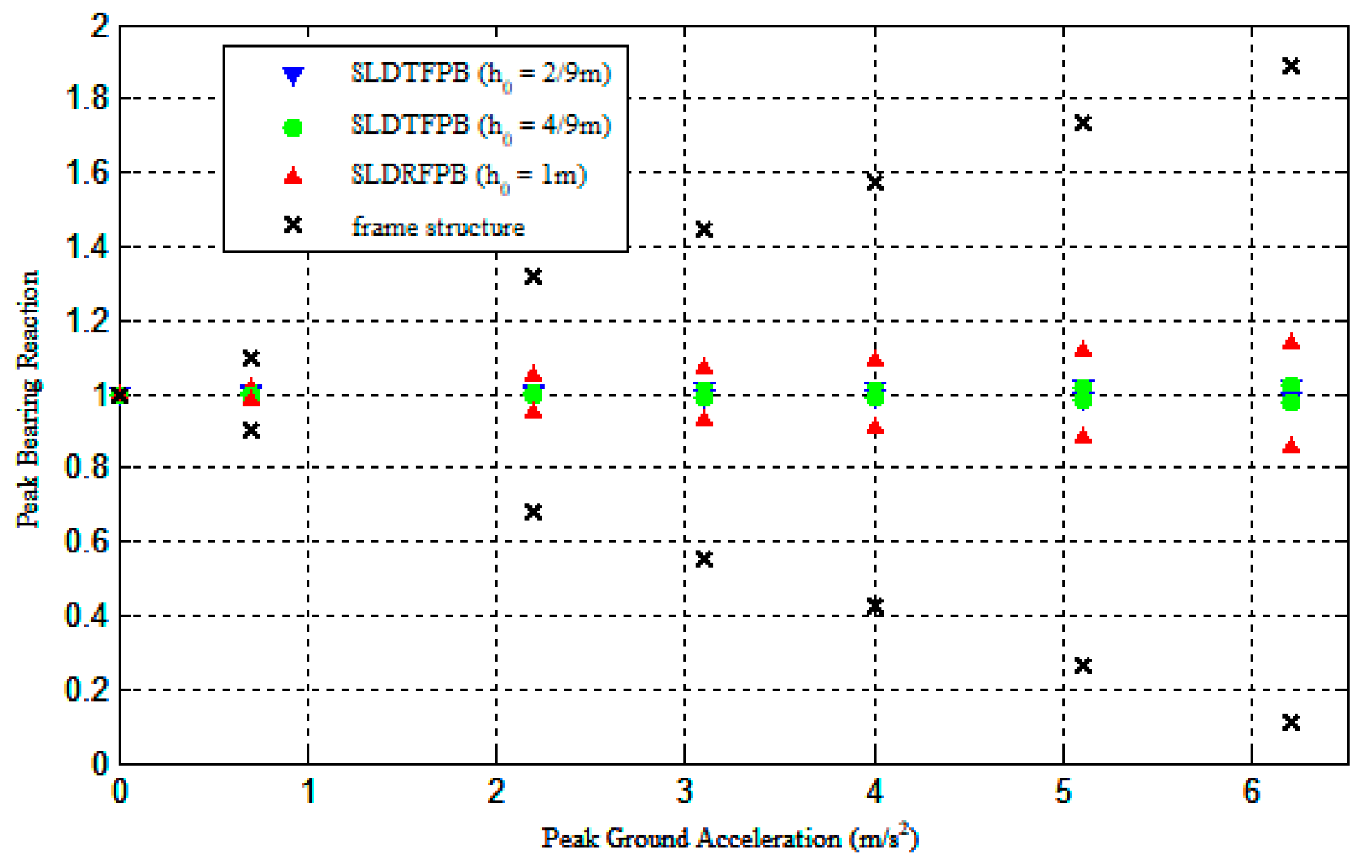1. Introduction
Earthquake is a main threat of buildings in their lifecycle. With increasing of seismic demand, destruction of buildings, especially buildings with important functions such as hospitals, power stations and landmark buildings, is necessary to avoid. Therefore, seismic performance of structures subjected to rare and even very-rare earthquakes needs further improvement.
Isolation structure is a proven resilient structure system, which can better withstand given ground motion hazards. Various isolation techniques are widely used in buildings and bridges, and among them, rubber bearing and friction pendulum bearing (FPB) are the two most used isolation techniques. Rubber bearing has small isolation stiffness and good vertical bearing capacity. When structures with rubber bearing are subjected to design earthquakes, deformation of the superstructure and the isolation layer is small. In past decades, a great deal of effort has been made to improve the isolation effect, or in other words, to isolate the seismic response of the superstructure [
1,
2]. Rubber-bearing isolation with active or semi-active control are also studied to the increase isolation effect [
3,
4,
5,
6] subject to design and rare earthquakes. A MR (Magneto-Rheological) damper is suitable for semi-active control in a base-isolated structure under long-period earthquakes [
7]. Different damping strategies are determined by long-period earthquake ground motions or short-period ground motions [
8]. Long-period earthquake ground motions include frequent earthquakes with 63% exceeding probability in 50 years, rare earthquakes with 2–3% exceeding probability in 50 years and very-rare earthquakes with 0.5% exceeding probability in 50 years [
9]. The improvement of horizontal deformation capacity of the isolation layer is seldom studied, since the isolation layer will not be destroyed by design or rare earthquakes. However, isolation structures have a risk of collapse when subjected to very-rare earthquakes. Deformation of isolation bearing without an inhibiting device will exceed its deformation capability under very-rare earthquakes [
10]. At the least, when the increase of deformation is stopped by an inhibiting device, the safety of the superstructure is no longer guaranteed, since the isolation layer cannot provide an isolation effect. Unfortunately, there is a contradiction between increasing deformation capacity of rubber bearing and increasing its isolation effect. Specifically, horizontal displacement of rubber bearing is limited to the length and height of the rubber: increasing length and height at the same time can guarantee economy, but meanwhile, horizontal stiffness also increases. As a result, rubber bearing is not suitable for isolation structures which need seismic performance under very-rare earthquakes.
Friction pendulum bearing is another common isolation bearing. Restoring force of FPB is determined by the horizontal component of the bearing reaction. More importantly, FPB can avoid weaknesses of rubber bearing, i.e., contradiction between deformation capability and isolation effect. This is because isolation frequency is mainly determined by the radius of FPB, instead of the length of bearing as in rubber bearing. Seismic performance of structures equipped with FPB has been demonstrated by a series of experiments and engineering practice [
11,
12,
13,
14,
15,
16]. Nonlinear biaxial springs are used to build the model of a friction pendulum based on the principles of the classical theory of plasticity [
17]. Torsional behaviors and P-delta (P-D) effects of the structure isolated with FPB were also studied by different researchers [
18,
19,
20]. Considering both isolator properties and earthquake main characteristics as random variables, seismic reliability of a base-isolated structure equipped with FPB is also evaluated [
21]. In addition, some special friction pendulum bearings, e.g., XY-FP isolator, double concave FPB and triple concave FPB, have been developed for preventing uplift and obtaining large restoring force and low sensitivity to the frequency content of the input [
22,
23,
24,
25,
26,
27,
28,
29]. FPB with variable stiffness or variable friction coefficient is effective for a wide variety of structures and isolator properties, even when subjected to near-fault ground motions [
30,
31,
32,
33,
34]. Other isolation devices such as marble-graphite slide seismic isolator [
35], polymeric bearings [
36] and thermal isolation made of mineral wool and polyurethane foam [
37,
38] have also been proposed. These previous studies indicate the mechanical properties and isolation effect of classic or developed FPBs instead of safety of the isolation layer when subjected to rare earthquakes. However, when subjected to very-rare earthquakes, the lack of deformation capacity of FPB is more significant. It is also unfortunate that horizontal deformation of FPB is still limited by the size of bearings. Size of FPB is determined by space for placing FPB. Space of FPB is limited because classical friction pendulum bearings are mainly used at the bottom of structural columns or bridge piers, in general. As a result, it is necessary to develop an isolation technique for satisfying seismic demand of the isolation layer under very-rare earthquakes.
The goal of this paper is to develop innovative FPB, namely “super-large displacement rotation friction pendulum bearing” (SLDRFPB) and “super-large displacement translation friction pendulum bearing” (SLDTFPB) to realize large deformation of the isolation layer and thus to achieve isolation safety subjected to very-rare earthquakes. Since the superstructure is completely supported by one SLDRFPB or SLDTFPB, avoiding locating them separately under the column can beat the restriction of space for placing FPB, leading to effectively achieving super-large size and super-large deformation. Large radius and small friction coefficient, which can be easily achieved in SLDRFPB and SLDTFPB, guarantee good isolation resilience. As a result, the developed SLDRFPB and SLDTFPB are suitable for important isolation structures which need to maintain sufficient safety and functionality subjected to even very-rare earthquakes. It is worth mentioning that, since damage of the isolation system is concentrated in the isolation layer, the increased cost for the implementation of the developed SLDRFPB or SLDTFPB is not too much. In addition, the two forms of developed SLDFPBs can meet the requirements of most structures. Motion state of superstructures equipped with SLDRFPB and SLDTFPB, as well as space utilization of SLDRFPB and SLDTFPB, are different. In practical implementation, the choice of SLDRFPB or SLDTFPB depends on the inclination of the superstructure and space shape of the foundation. Particularly, superstructures equipped with SLDRFPB and sliding frame in SLDTFPB will move rotationally on an arc orbit, and the rotational inertia of these components cannot be ignored. As a result, the traditional design method of friction pendulum bearing is no longer suitable. We develop a design method to accurately and conveniently evaluate seismic performance of SLDRFPB and SLDTFPB. This method is expected to be used in practical projects.
The rest of the paper is organized as follows.
Section 2 describes system configuration of SLDRFPB and SLDTFPB, followed by establishment of motion equations of isolation systems equipped with SLDRFPB and SLDTFPB in
Section 3, and mechanical properties of the two developed bearings are illustrated. Seismic responses of superstructures and isolation layers are presented in
Section 4 to demonstrate good seismic performance of SLDRFPB and SLDTFPB when subjected to rare and very-rare earthquakes.
2. System Configuration of SLDRFPB and SLDTFPB
As is known, each classic FPB is located separately under the column. Different from classical FPB, the developed super-large displacement friction pendulum bearing has one or several spherical shells of super-large span and super-large curvature radius above the foundation. The integrated sliding isolation layer consists of spherical shell with sliding surface and sliding block under each column or sliding frame. The sliding isolation layer with one spherical shell is called super-large displacement rotation friction pendulum bearing (SLDRFPB), as shown in
Figure 1. The superstructure can roll along the spherical shell upwards opening. Sliding blocks under nondeformable frame columns slide on the surface of the super-large spherical shell. Since the superstructure serves as a huge sliding block of classic FPB, super-large horizontal displacement of the isolation layer can be achieved.
Figure 2 shows the sliding isolation layer with several spherical shells. It is noted as super-large displacement translation friction pendulum bearing (SLDTFPB) because of the translation motion pattern of the superstructure. Several sliding frames, which are used as the basement or mechanical floor, act as sliding blocks of classic FPB. Each group of spherical shells is made up of two of the same spherical shells with large radius and span, which are located at the top and bottom of one sliding frame, respectively. The superstructure connects with the top of SLDTFPB and they slide together on the top surface of these sliding frames. Sliding frames slide on the bottom of SLDTFPB at the same time. Particularly, the superstructure equipped with SLDTFPB translationally moves along its orbit. The reason is that when the top surface of each group couples rigidly and forms integrally, each sliding frame slides together between corresponding spherical shells due to compatibility of vertical deformation.
Figure 3 shows the details of the two developed FPBs. Similar materials and manufacturing processes were used to manufacture SLDRFPB and SLDTFPB. The spherical shell is integrally concreted with high-strength concrete, full cross-section reinforcement and a spherical corrosion-resistant plate. Configuration of the sliding block is similar to a flat stainless-steel cylinder with a spherical outside surface and horizontal inside surface. In order to avoid failure of the spherical shell caused by local compression, the outside surface of the sliding block and spherical shell have the same shape and radius. Teflon, silicone lubricant or other low-friction materials and antifriction are adopted on the surface of the spherical shell and sliding block. The coefficient of friction and compressive bearing capacity of Teflon can satisfy design requirements [
39]. The Bevel edge of the sliding block is beneficial to smooth sliding. Some end joints welded on different directions are used for connecting additional reinforced girders and columns. Cast-in-site columns and sliding blocks are connected by stud anchors and bolt nails.
SLDRFPB and SLDTFPB are suitable for different situations derived from the quantity and location of spherical shells. As shown in
Figure 1 and
Figure 2, the motion of the superstructure equipped with SLDRFPB or SLDTFPB is rotating or translating, respectively. Width of SLDRFPB is designed much larger than that of the first story of the superstructure in order to reserve super-large horizontal sliding displacement. Considering the fact that deformation of SLDTFPB occurs between the top and bottom of the isolation layer, the width of SLDTFPB is not necessarily larger than that of the superstructure, while the height of the whole isolation layer is not small. In practical implementation, the choice of SLDRFPB or SLDTFPB depends on the inclination of the superstructure and space shape of the foundation.
3. Mechanical Properties of Isolation Systems Equipped with SLDRFPB and SLDTFPB
Similar to classical FPB, effective restoring force of SLDRFPB and SLDTFRB also comes from the lateral component of bearing reactions. However, direction of bearing reaction, resultant moment and resultant friction force of SLDRFPB and SLDTFPB are different from those of classical FPB. The reaction force of each classical FPB is always vertical. The reaction force of each column in SLDRFPB is towards the center of the spherical shell. In SLDTFPB, a group of bearing reactions in the same basement cavity point to two circle centers of the top and bottom spherical shells, and in different cavities, bearing reactions at corresponding columns have the same directions. Therefore, horizontal stiffness between classic FPB and the developed SLDRFPB and SLDTFPB are different. In addition, inertia moment of the superstructure between classic FPB and the developed SLDRFPB and SLDTFPB also play different roles according to different forms of movement. Translation movement of the superstructure equipped with classical FPB behaves as a little vertical vibration with small amplitude and horizontal vibration with large amplitude. The superstructure equipped with SLDRFPB rolls around a unique circle center of the spherical shell subjected to earthquakes, so that inertia moment of the superstructure has to be considered in the equation of motion. The sliding frame in SLDTFPB rotates over the ground, and the superstructure equipped with SLDTFPB rolls relative to the sliding frame. Motion of the superstructure with SLDTFPB relative to the ground is the same translation as that of the superstructure with classical FPB. In order to distinguish mechanical properties of SLDRFPB and SLDTFPB, motion equations of isolation systems, bearing reaction and friction force are investigated in the following subsections of
Section 3.
3.1. Motion Equations of Isolation Systems Equipped with SLDRFPB and SLDTFPB
Since motion of isolation systems equipped with the developed SLDRFPB or SLDTFPB constitutes a rotational component, and bearing reaction cannot be determined straightforward, D’Alembert principle is not suitable for establishing motion equations of the isolation system with SLDRFPB or SLDTFPB. The Lagrange principle is more convenient to establish the motion equations. Assume that:
Mass of each story is evenly distributed on the surface.
Superstructure satisfies rigid floor assumption.
Columns have infinite vertical stiffness, and superstructure is “shear-type”.
Considering one-dimensional horizontal seismic action, the vertical acceleration of the superstructure is caused by the inclination of the isolation layer.
Each slider is in point contact with the sliding surface so that the bearing reaction points to the center of the spherical surface.
Seismic loads are expressed as the product of mass and ground acceleration.
According to the Lagrange principle, the equations of motion are described by Equations (1)–(3),
where variables include
,
, or
represent the inclination angle of isolation layer, the relative displacements between each story of the superstructure and isolation layer and the horizontal displacements of each story between each story of the superstructure and ground,
is kinetic energy of the system,
is potential energy of the system,
is work of ground motion, which is determined by horizontal response of each degree of freedom,
represents work of friction force, based on the relative displacement response of two closed surfaces, and
is work of the damping force in the superstructure.
Figure 4 shows an isolation structure equipped with SLDRFPB. As shown in
Figure 4, degrees of freedom of the isolation system equipped with SLDRFPB includes the inclination angle of isolation layer
and relative displacements
between each story of the superstructure and isolation layer. When the bottom of the spherical shell is located at the origin of coordinates, displacement responses of the isolation layer are described by Equation (4).
where
is the radius of the spherical shell in SLDRFPB, and
is the radius of the movement orbit of the center of the bottom of the superstructure, which is equal to the difference between the radius of the spherical shell
and the depth of the isolation layer
.
We assume
,
due to the small inclination angle, which will be validated in
Section 4. By substituting Equation (4) into Equations (1) and (2), and ignoring higher order items, we have
where
is mass of the
i-th story, which is lumped at the surface of the floor,
is the distance between the circle center of the spherical orbit and the center of the
i-th story,
is inertia moment of the
i-th story,
is the algebraic sum of the friction force,
is horizontal stiffness of the
i-th story and
is horizontal damping of the
i-th story. Specifically,
i = 0 represents the isolation layer.
,
and
should be adopted as zero in practical implementation since they represent unreal stiffness, damping over the top story and relative displacement of the isolation layer.
Degrees of freedom in the isolation system equipped with SLDTFPB are outlined in
Figure 5. The inclination angle of sliding frame
and horizontal displacements
are used in the analysis. The relative displacements from the center of the sliding frame to the top and bottom of the isolation layer are the same so that displacement responses of the isolation layer are expressed as Equation (7).
where
is the radius of the spherical shell in SLDTFPB,
is the angle of the line between the bottom of the side column in the sliding frame and the corresponding orbit center and
is height difference in the shaft of the side column in the sliding frame between the top and bottom of the isolation layer. Equation (7) shows that the movement orbit of the isolation layer in SLDTFPB is an arc whose center height is
and radius is
. The superstructure will move along the arc and keep upright when subjected to earthquakes.
By substituting Equation (7) into Equations (1) and (3), the motion equations of the isolation layer and each story are further described by:
where
is total mass of basements which are sliding frames inside SLDTFPB, and
is total inertia moments of basements.
By comparing Equations (5), (6), (8) and (9), it can be found that mechanical properties of SLDRFPB and SLDTFPB are complicated and different from those of classical FPB. Seismic loads will not only cause lateral acceleration but also angular acceleration. This is because the superstructure equipped with SLDRFPB and sliding basement in SLDTFPB rolls along their orbits of the spherical shell, respectively. Angular acceleration decomposition, as well as rotational kinetic energy, make the solution of the equations more complex, as opposed to that of classic FPB. In addition, the stiffness between the isolation layer and each layer of the superstructure is not zero. It is validated by the component force of gravity acting on each floor when the superstructure is inclined.
3.2. Bearing Reaction and Friction Force of SLDRFPB and SLDTFPB
According to the Coulomb friction principle, the friction coefficient under static and dynamic conditions is constant. Friction force in Equations (5) and (8) is determined by the state of motion and the reaction force. When the friction coefficient and curvature radius of the spherical shell surface remain unchanged, the term of friction force in the equation of motion yields the product of the symbolic function of the velocity of the isolation layer and the algebraic sum of the bearing reaction force, i.e.,
where
is friction coefficient between the sliding block and sliding surface, and
is the bearing reaction corresponding to friction force. In particular, the friction force in SLDTFPB is divided into the top and the bottom parts. The values of two parts are different, but the results of motion state judgement are the same.
Bearing reaction cannot be solved based on the Lagrange principle. In that case, we establish the equilibrium equation according to D’Alembert’s principle. Lateral and vertical resultant forces of statically determinate frame structures with single span and multi-story are equal to zero. Friction force is difficult to describe straightforward because it changes with the motion state. The friction coefficient is usually less than 0.1, or even less than 0.05, so that the friction force has little effect on the reaction force. It is more convenient to consider the friction coefficient as 0 when solving the force. A force analysis sketch of the isolation system equipped with SLDRFPB is shown in
Figure 6.
When the friction force is zero, the equilibrium equation of the isolation system equipped with SLDRFPB can be written as:
In this case, each bearing reaction can be simplified as:
where
represents the angle between the vertical direction and the direction from the sliding block to the center of the spherical orbit,
and
represent the left and right bearing reactions of columns respectively, and
represents the angle between the vertical direction and the direction from the edge of the
i-th story to the center of the spherical shell. It is noted that friction force has little influence on redistribution of the bearing reaction force, especially the algebraic sum of bearing reaction force when the friction coefficient is small. The algebraic sum of bearing reaction is expressed in terms of the result of Equation (12) under static condition,
It can be seen that seismic load, location of sliding frame and state of motion have less influence on the result of Equation (13), so that the value of bearing reaction in the equation of motion can be adopted as the bearing reaction force of the original position. The conclusion can be further extended to statically indeterminate structures such as multi-span frame structures since the bearing reaction is distributed more uniformly.
Assume that each sliding frame has only one sliding contact point with the surface and friction force is zero. Then, the force analysis sketch of the isolation system equipped with SLDTFPB can be described, as in
Figure 7.
According to the D’Alembert’s principle, the resultant force of the superstructure equipped with SLDTFPB and each sliding frame are both zero, yielding the equations of the bearing reaction at the top and bottom surface as:
which can be further simplified as,
The algebraic sum of the original bearing reaction under the static condition is described by
which is a little smaller than that under the seismic condition. The maximum error is no more than 1% in time history analysis.
Once each item in the equation of motion can be determined, mechanical properties of isolation systems equipped with SLDRFPB and SLDTFPB can thus be compared.
3.3. Mechanical Properties of Isolation Systems Equipped with SLDRFPB and SLDTFPB
Since directions between friction force, seismic load and motion of both SLDRFPB and SLDTFPB are different, and also since the inertia moment of rotation of the superstructure equipped with SLDRFPB and rotation sliding frame in SLDTFPB cannot be ignored, mechanical properties of isolation systems equipped with SLDRFPB and SLDTFPB are different from those of classic FPB. It is known that the motion equation of the classic FPB is described as [
16],
When the superstructure is regarded as a rigid body, and the motion state of the isolation layer is moving, the equation of motions of SLDRFPB, whose degree of freedom represents horizontal displacement of the isolation layer, can be further derived as a similar form of the motion equation of friction pendulum bearing. By substituting Equation (13) into Equation (5), we have
Equations (19) and (20) have the same formula. The term of inertia force, term of friction force and term of seismic load in Equation (20) are different from those in Equation (19). In order to distinguish Equations (19) and (20), define equivalent radius, equivalent friction coefficient and equivalent mass of SLDRFPB as coefficient of reaction force item, friction force item and seismic load item,
In order to visually demonstrate the mechanical properties of SLDRFPB, a 20-story frame structure with story height h = 3 m and framing span L = 35.3 m is established. In order to investigate the effect of depth of isolation layer on equivalent radius of SLDRFPB, depth of isolation layer
varying from 0.2 to 2 m is adopted.
Figure 8 shows the relation between equivalent radius of the frame structure equipped with SLDRFPB and depth of isolation layer
. Radius of mass orbit
and equivalent radius
calculated from the nature period of the isolation system are also shown in
Figure 8. It can be seen that equivalent radius
is consistent with the equivalent radius
for the isolation system equipped with SLDRFPB. Isolation frequency calculated from equivalent radius has good accuracy. Equivalent radius derived from Equation (21) can be used in engineering design. On the contrary, radius of the spherical orbit is generally larger than the equivalent radius. As a result, poor estimation may be obtained from the theory of classical FPB. In addition, both radius of mass orbit and equivalent radius decrease with the increase of the depth of the isolation layer. It is consistent with the geometric relationship of spherical shell orbit and Equation (21). According to Equation (22), the equivalent friction coefficient of SLDRFPB is usually larger than that of spherical surface. A higher superstructure has smaller
and larger equivalent friction coefficient. In addition, according to Equation (23), the ratio of
to
is exactly the same as the ratio of
to
, so that
is always larger than
.
Similar to SPDRFPB, by substituting Equation (18) into Equation (8), equation of motions of SLDTFPB becomes
Equivalent radius, equivalent friction coefficient and equivalent mass of SLDRFPB are shown as Equations (25)–(27), respectively. Based on Equations (26) and (27), equivalent friction coefficient
of SLDTFPB is approximately equal to the friction coefficient of the spherical surface.
is slightly larger than
due to the relative motion between the sliding frame and spherical surfaces.
Figure 9 shows the equivalent radius
of the same frame structure equipped with SLDTFPB, the equivalent radius
calculated from nature period and the movement orbit of the isolation layer
. Depth of each spherical shell
varies from 0.05 to 0.45 m. The side pillar of the sliding frame is 3 m tall, which is the same as the story height of the superstructure. Height difference in the center shaft between the top and bottom of the isolation layer
is equal to
. As shown in
Figure 9, the equivalent radius of SLDTFPB is identical to the radius of the real track of the superstructure. Both of them can be used in the estimation of isolation frequency. In particular, the equivalent radius is approximately equal to two times the radius of each spherical shell. Besides the depth of each spherical shell
which determines the radius of each spherical shell,
has an influence on the equivalent radius when the radius of the spherical shell is unchanged. Based on Equation (25), the relations between two radii and
are shown in
Figure 10.
of the model in
Figure 10 is 0.22 m. Both radii decrease with increase of
. The equivalent radius of SLDTFPB is slightly smaller than the orbit radius of the superstructure. The difference between these two radii is almost irrelevant to
.
3.4. Comparison of Mechanical Properties of Isolation Systems Equipped with SLDRFPB and SLDTFPB
Mechanical properties of isolation systems equipped with SLDRFPB and SLDTFPB can be compared according to Equations (20)–(27). It can be seen in Equations (21) and (25) that vertical distribution of mass in the superstructure has an influence on the equivalent radius of the isolation layer.
Figure 11 compares the relations between the equivalent radii of the two developed SLDFPBs and story number. A group of frame structures with different story numbers are equipped with the same SLDRFPB or SLDTFPB. Height of each story is adopted as h = 3 m and frame spans are adopted as L = 35.3 m. Story number varies from 1 to 20. As shown in
Figure 11, the equivalent radius of SLDRFPB decreases with increasing of number of stories. This is because the increase of distance between the center of gravity and the center of the circle leads to the decrease of the average rotation radius of the whole superstructure when it rolls around the center of the circle. On the other hand, the equivalent radius of SLDTFPB increases a little with the number of stories because the track of the superstructure equipped with SLDTFPB does not change with the number of stories. Furthermore, with the increase of mass of the superstructure, a smaller mass ratio between the rotational sliding frame and the translational superstructure brings less influence on the equivalent radius of SLDTFPB.
In order to further investigate the isolation effect of the two developed SLDFPBs with corresponding parameters, equivalent radii of SLDRFPB and SLDTFPB with subequal track radius of superstructure are compared in
Figure 12. The horizontal axis about curves of SLDRFPB in
Figure 12 represents the depth of SLDRFPB,
, and the horizontal axis about curves of SLDRTPB in
Figure 12 represents a 9/2 the depth of SLDTFPB,
, which cannot be readily seen in this figure. Span of the sliding frame in SLDTFPB is 1/3 span of the superstructure, and the mass of each sliding frame is 1/3 the mass of each story. According to the geometric relationship in Equations (28) and (29),
is selected as 9/2 so that
in SLDRFPB and SLDTFPB is the same. From
Figure 12, it can be seen that these curves which represent
,
and
basically coincide. The equivalent radius of SLDRFPB is always less than that of SLDTFPB.
In general, the equivalent radius of SLDRFPB is smaller than the radius of the spherical shell, and the equivalent friction coefficient and equivalent mass of SLDRFPB are larger than the friction coefficient of the sliding surface and mass of the isolation layer. Thus, restoring force, friction force and seismic load are magnified in different scales. The equivalent radius of SLDTFPB is almost twice as much as the spherical shell and is close to the orbit radius of the superstructure’s motion. The equivalent friction coefficient of SLDTFPB is similar to the friction coefficient of the sliding surface, and the equivalent mass of SLDTFPB is a little larger than the mass of the isolation layer.
Generally, isolation frequency of the isolation layer with large equivalent radius is small, and damping capacity of the isolation layer with large equivalent friction coefficient is large. According to the force transfer coefficient
of a single degree of freedom subjected to force vibration [
40], which is described as,
where
is frequency ratio of transfer force to the load and
is damping ratio, bearings with a smaller equivalent friction coefficient have a better isolation effect. When isolation frequency is quite small, increasing the equivalent radius has a small influence on the isolation effect.
4. Seismic Performance of Isolation Systems Equipped with SLDTFPB and SLDRFPB
In order to illustrate seismic performance of an isolation structure equipped with SLDRFPB or SLDTFPB subjected to rare and very-rare earthquakes, the high-rise frame structure with 20 stories is established, as shown in
Figure 13. Length and width of each story are 25 m, and height of the structure is 60 m. Natural period and damping ratio of the structure are 1.48 s and 0.05, respectively.
A multi-degree of freedom model is established in MATLAB, and time-history analysis of the isolation structure is simulated. The superstructure of the isolation structure is simplified to an elastic shear model based on Equation (9). The mode results in MATLAB are similar to those in SAP2000. Assume that the structure with large deformation has constant stiffness. This assumption is only used for simplifying structures which have not been equipped with isolation bearing. We note that in the model of the structure equipped with SLDRFPB, the stiffness between the isolation layer and the upper structure of each layer is not zero. The damping matrix is determined according to the Rayleigh damping model. The mass matrix and the stiffness matrix of the whole isolation structure and the first- and second-order mode frequencies of the superstructure are used to simulate the effective damping matrix of the superstructure. The results of time-history analysis are reliable because only the damping force of the isolation layer is an approximate result, which is much less than that of the friction force in the equation of the isolation layer. Friction force of the sliding surface follows the Coulomb friction principle. On the basis of Equations (26) and (27), the models of SLDRFPB and SLDTFPB are idealized. The horizontal stiffness of the isolation layer is simulated by the concentrated mass of the horizontal translational spring connection. The classical 4-order Runge-Kutta method is used to carry out the nonlinear numerical test of SLDRFPB and SLDTFPB in order to consider the stick-slip motion of the isolation layer.
The main characteristics of five natural ground motions used in the time-history analysis are listed in
Table 1. Results of two artificial seismic waves are also used to evaluate seismic performance. Each earthquake motion is adjusted by the reference of different peak ground accelerations (PGA) and follows Chinese standards. Seismic precautionary intensity of the structure is 8 degrees. Accordingly, an earthquake wave whose PGA is 0.7 m/s
2 represents a frequent earthquake, and earthquake wave whose PGA is 4 m/s
2 represents a rare earthquake and an earthquake wave whose PGA is 6.2 m/s
2 represents a very-rare earthquake [
9].
As a three-dimensional structure, each story of the superstructure rotates around the center of the sphere under a unidirectional earthquake, and the radius equals the distance from the center of the sphere to the center of each layer. For the whole floors whose thickness is much less than the length and width, moment of inertia around the longitudinal axis is equal to the sum of the moment of inertia around two vertical axes in the plane, as shown in Equation (31):
The inertia moment of a regular quadrangle around any set of vertical axes in the plane has the same value so that incidence angle between the earthquake and the overall coordinate of the structure has no influence on the motion equation of the isolation layer. Since mass is distributed uniformly, a three-dimensional structure can be simplified to a two-dimensional in-plane problem.
Based on the analysis in
Section 3 and structural requirements, depth of SLDTFPB is selected as 2/9 and 4/9 m, and depth of SLDRFPB is selected as 1 m for comparison. The friction coefficient is selected as 0.01 [
41,
42], which can represent the friction coefficient of liquid or graphite lubricants. According to the geometrical relationship between radius and span, the spherical radius of SLDRFPB is 156.75 m, spherical radii of SLDTFPB are 78.2 and 39.3 m, so that the equivalent radius of SLDRFPB is 129.2 m, and equivalent radii of SLDTFPB are 153.1 and 74.7 m, respectively. Mean value of the response subjected to seven ground motions is shown as follows.
4.1. Seismic Response of Superstructures Equipped with SLDRFPB and SLDTFPB
Inter-story drift ratios of isolation structures equipped with SLDTFPB or SLDRFPB are outlined in
Figure 14. It can be seen that inter-story drift ratio of each model is no more than 0.1% when the structure is subjected to frequent earthquakes. Some plastic damage (i.e., inter-story drift ratio is much larger than 0.1%) can be observed in the frame structure without isolation bearing subjected to earthquakes whose PGA is 2.2 m/s
2. It is no wonder that the frame structure without isolation bearing finds it hard to survive rare earthquakes. Structures with SLDTFPB or SLDRFPB can withstand the seismic load whose PGA is up to 6.2 m/s
2, and in this case, maintain approximate elasticity, so that SLDRFPB and SPDTFPB have superior sufficient isolation effects under rare or very-rare earthquakes. This is because a large equivalent radius leads to small horizontal stiffness and thus brings a good isolation effect. In addition, inter-story drift ratio of frame structure increases linearly with earthquake intensity in completely elastic analysis. Inter-story drift ratios of three isolation structures increase nonlinearly with PGA. This is because an isolation layer subjected to stronger earthquakes can avoid a stick pattern of the isolation layer induced by friction force. Moreover, inter-story drift ratio of SLDTFPB with a different equivalent radius is similar, and inter-story drift ratios of SLDTFPB and SLDRFPB with similar equivalent radius but different equivalent friction coefficient are different. This is validated by a similar isolation effect of isolation systems with different super-low frequency according to the change of the response spectrum in long periods. It also illustrates that the isolation effect of super-large displacement friction pendulum bearing is mainly determined by the equivalent friction coefficient.
Figure 15 shows the relations between maximum vertical displacements of superstructures and PGA. In particular, the edge of the frame with SLDRFPB vibrates most violently in the vertical direction, and different parts of the frame with SLDTFPB behave identically to vertical vibration. It helps to understand the difference of vertical influence between rolling motion form and translation motion form along the arc. As shown in
Figure 15, although the curve of SLDRFPB is much higher than those of SLDTFPBs, vertical displacements of the superstructure equipped with both SLDRFPB and SLDTFPB are small even when subjected to rare and very-rare earthquakes, thereby destruction of the superstructure from inclination of each story could not occur. Safety of both SLDRFPB and SLDTFPB can be achieved. Moreover, it can be concluded that the ratio between the response of the edge of each story and the response of the center of each story in the structure with SLDRFPB is approximately equal to
.
Figure 16 shows the relations between vertical accelerations of the center of superstructures equipped with SLDTFPB or SLDRFPB and PGA. Maximum vertical acceleration of the superstructure is also inconspicuous. A strong sense of weightless or overweight in the structure could not occur even when subjected to very-rare earthquakes, so that the comfort of both SLDRFPB and SLDTFPB can be satisfied. In addition, this vertical response is determined by the horizontal isolation effect and the track radius of the superstructure. As a result, the vertical response increases with the decrease of the radius of bearing, and, the better the isolation effect of bearing, the smaller the vertical response.
4.2. Seismic Response of Isolation Layers Equipped with SLDRFPB and SLDTFPB
Seismic response of the superstructure represents the isolation effect of bearing. Besides, the seismic response of the isolation layer represents safety and resilience of the isolation system.
Figure 17 shows the relations between maximum displacements of isolation layers equipped with SLDTFPB of different depths or SLDRFPB and PGA. The vertical axis in
Figure 17 denotes the maximum value of the response among seven ground motions, so that it represents the worst case of lateral deformation of the isolation layer. As shown in
Figure 17, maximum displacement of the isolation layer subjected to a very-rare earthquake is more than 1 m. This displacement exceeds the horizontal deformation capacity of classic FPB, but it is much less than the deformation capacity of SLDRFPB and SLDTFPB. Large deformation of the isolation layer will not destroy the structure. In this sense, SLDRFPB and SLDTFPB are particularly suitable for isolation structures which need sufficient seismic performance when subjected to very-rare earthquakes. In addition, since SLDTFPBs with different equivalent radii and SLDRFPB have similar and sufficient deformation, the design requirements of deformation of the isolation layer do not limit the parameter selection of SLDRFPB and SLDTFPB.
It can also be seen in
Figure 17 that the increase of displacement is uneven. There is no obvious pattern between the increment of displacement of the isolation layer and that of the isolation effect. This is because the isolation effect comes from the relative movement between the superstructure and the isolation layer, but the displacement is also determined by direction of movement. Superstructures may bond at random locations when the instant seismic load is not strong, while the sliding direction of superstructures at the next moment is uncertain. Moreover, the uncertainty is more obvious when subjected to small earthquakes, due to larger probability of a stick situation. Another reason is that the maximum value of maximum displacements of seven waves instead of the average value of them has been described in
Figure 17. The earthquake wave which leads to the maximum seismic response determines this value, so that these curves in
Figure 17 look more random than those in other figures.
Figure 18 shows the residual displacements of these isolation bearings. Reset capability represents isolation resilience of SLDRFPB and SLDTFPB. As shown in
Figure 18, residual displacement is less than 0.15 m in case of very-rare earthquakes. When only considering SLDRFPB or SLDTFPB as a foundation of structure, and ignoring other functions of SLDFPB except isolation ability, bearing capacity is not affected by residual displacement, and residual inclination of the superstructure is tiny. In this way, residual displacement of the isolation layer will not affect the use of the superstructure. In particular, mechanical properties and the isolation effect of SLDFPB with residual displacement are basically unchanged. In case of bearing with initial displacement, extra residual displacement is always smaller than that of the bearing without initial displacement. As a result, residual displacement can be neglected in real-life engineering application.
It can be found that residual displacement of SLDTFPB with a smaller equivalent radius is smallest among the three models of the developed SLDFPB in this section. The reason is that this bearing has the smallest maximum displacement and the smallest maximum theoretical residual displacement. Maximum theoretical residual displacement is defined as the position where the restoring force equals the friction force. Both maximum displacement and maximum theoretical residual displacement increase with equivalent radius, and therefore, small equivalent radius together with deep isolation layer should be adopted in the design strategy in the sense of reset capability of the isolation layer.
Figure 19 describes peak bearing reactions of SLDRFPB and SLDTFPB, in which vertical axis represents the ratio between bearing reaction under earthquake and that under static state. When the bearing reaction is greater than zero, the bottom of the column is always under compression, and the isolation layer has the ability to resist overturning. As shown in
Figure 19, the bearing reactions of structures with SLDRFPB or SLDTFPB almost remain unchanged when subjected to rare and very-rare earthquakes. Superior overturning resistance and large vertical carrying capacity ensure seismic performance along the vertical direction. In general, SLDTFPB shows better isolation effect and better anti-overturning ability than SLDRFPB in case of similar equivalent radius and the same friction coefficient of the sliding surface.



